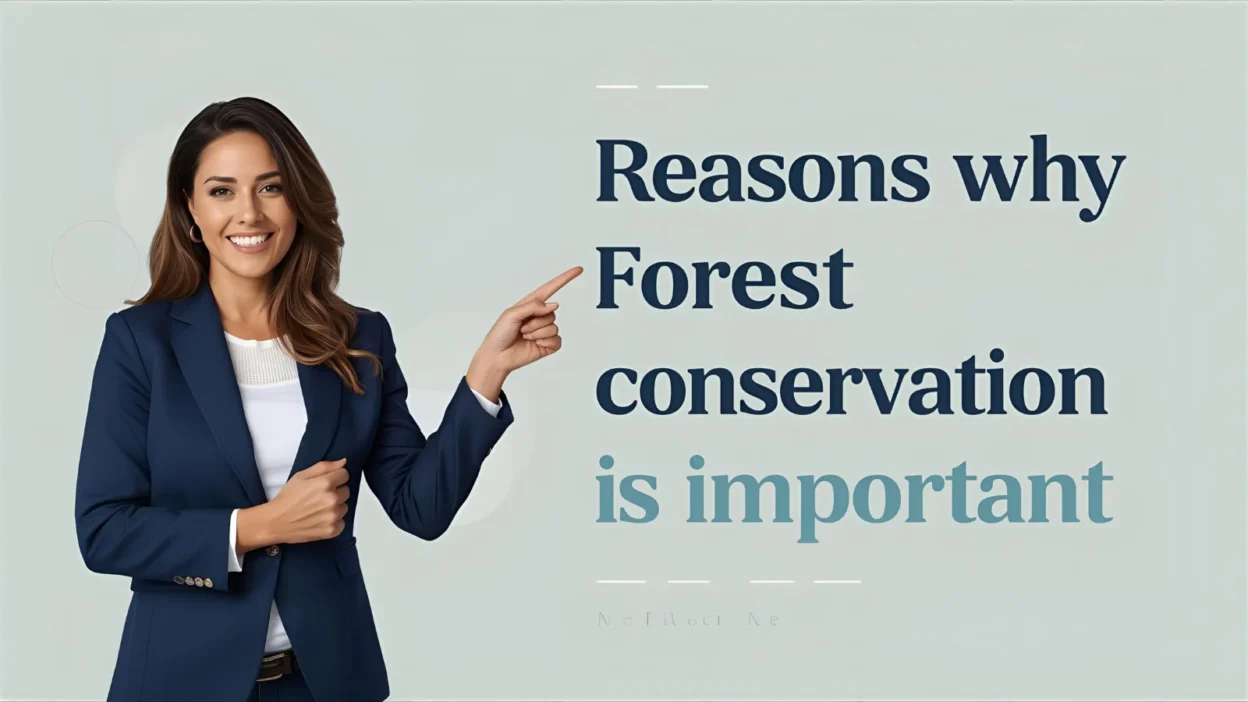Forests are the lungs of our planet, the cradle of biodiversity, and the foundation of human survival. They provide oxygen, regulate the climate, prevent soil erosion, and offer food, medicine, and livelihoods to billions of people.
Yet, every year, millions of hectares of forests disappear due to deforestation, urbanization, and illegal logging. Forest conservation isn’t just an environmental issue — it’s a global responsibility.
In this article, we’ll explore 48 powerful reasons why forest conservation is important, and how protecting our green cover safeguards the Earth and future generations. 🌍
1. Forests Produce the Oxygen We Breathe
Forests act as the planet’s lungs, absorbing carbon dioxide and releasing oxygen through photosynthesis.
💨 A single mature tree can produce enough oxygen for two people every year. Without forests, the air we breathe would be dangerously unbalanced.
🌿 Example: The Amazon rainforest, often called the “lungs of Earth,” produces about 20% of the world’s oxygen.
💬 Quote: “If the forest dies, we die with it.”
2. Forests Absorb Carbon Dioxide and Fight Climate Change
Trees absorb carbon dioxide (CO₂), one of the main greenhouse gases responsible for global warming.
Conserving forests helps reduce carbon levels in the atmosphere and mitigates the effects of climate change.
🌱 Example: Forests store around 289 gigatonnes of carbon globally — that’s more than 30 times the world’s annual fossil fuel emissions.
3. Forests Preserve Biodiversity
Forests are home to over 80% of all land-based species — plants, animals, fungi, and microorganisms.
Conserving forests protects this rich biodiversity and ensures the survival of countless species.
🦜 Example: The rainforests of Borneo host orangutans, pygmy elephants, and over 15,000 plant species found nowhere else.
4. Forests Prevent Soil Erosion
Tree roots bind the soil and prevent it from washing away during heavy rains.
Without forests, erosion causes landslides, floods, and the loss of fertile topsoil essential for agriculture.
🏔️ Example: The Himalayan forests prevent massive soil erosion that could devastate downstream farmlands.
5. Forests Maintain the Water Cycle
Forests play a key role in the hydrological (water) cycle by absorbing rainfall and releasing water vapor through transpiration.
This process helps form clouds, maintain rainfall, and ensure water availability for rivers and agriculture.
💧 Example: The Amazon rainforest influences rainfall patterns across South America — even affecting weather in distant regions.
6. Forests Provide Food and Medicine
From fruits and nuts to herbs and honey, forests provide vital food sources for humans and animals.
They also supply medicinal plants, many of which are used in traditional and modern medicine.
🌿 Example: Over 25% of modern medicines come from rainforest plants — including treatments for cancer, malaria, and heart disease.
7. Forests Support Indigenous Communities
Millions of indigenous people live in forests, relying on them for food, shelter, and cultural identity.
Forest conservation protects not just nature, but also these ancient traditions and sustainable lifestyles.
🪶 Example: The Amazon tribes use forest resources without destroying them — an ideal model of coexistence.
8. Forests Reduce Flooding and Drought
By soaking up rainwater and slowly releasing it, forests help regulate water flow and reduce flood risks.
In dry seasons, they maintain groundwater levels, preventing droughts.
💡 Example: In Indonesia, mangrove forests protect coastal villages from tsunamis and floods.
9. Forests Promote Tourism and Recreation
Eco-tourism and forest parks attract travelers seeking nature’s beauty and adventure.
This generates income for local communities while encouraging sustainable forest management.
🌲 Example: National parks like Yellowstone and the Amazon draw millions of visitors each year, supporting both conservation and local economies.
10. Forests Provide Raw Materials and Livelihoods
Wood, bamboo, rubber, resins, and other forest products sustain global industries and rural economies.
When managed responsibly, forests can provide long-term livelihoods without depletion.
🪵 Example: Sustainable forestry in Finland supports both timber production and forest renewal.
11. Forests Act as Natural Air Purifiers
Trees filter dust, smoke, and pollutants from the air, improving overall air quality.
Urban green spaces, in particular, reduce air pollution and make cities healthier places to live.
🏙️ Example: Planting urban forests in cities like Singapore and Seoul has significantly improved air quality and reduced heat.
12. Forests Provide Habitat Corridors
Wildlife corridors — strips of forest that connect larger habitats — allow animals to move freely and maintain genetic diversity.
Forest conservation ensures these corridors remain intact, preventing species isolation and extinction.
🐅 Example: India’s “Project Tiger” connects forest areas to help tigers move safely between reserves.
13. Forests Help Regulate Global Temperatures
Forests absorb sunlight, cool the air through shade and evaporation, and regulate global and regional temperatures.
Without them, heatwaves become more frequent and intense.
🌡️ Example: Large-scale deforestation in Southeast Asia has already caused noticeable regional temperature increases.
14. Forests Offer Peace and Emotional Well-Being
Spending time in forests reduces stress, anxiety, and depression.
The Japanese practice of “Shinrin-yoku” (forest bathing) shows how being among trees restores mental clarity and peace.
🧘 Example: Studies reveal that just 20 minutes in a forest lowers cortisol (stress hormone) levels significantly.
💬 Quote: “In the silence of the trees, we hear ourselves again.”
15. Forest Conservation Ensures Future Sustainability
Protecting forests today ensures future generations can enjoy clean air, fresh water, and a stable climate.
It’s an investment in the planet’s longevity and humanity’s survival.
🌍 Example: Reforestation efforts in Costa Rica have restored over 50% of its lost forest cover — a global conservation success story.
🌲 Common Idioms and Expressions About Nature and Conservation
| Idiom / Expression | Meaning | Example |
|---|---|---|
| “Can’t see the forest for the trees” | Missing the bigger picture | We must see the forest for the trees when discussing climate change. |
| “Down to earth” | Practical or realistic | Conservationists are often very down to earth. |
| “Make hay while the sun shines” | Act while conditions are good | We must act now to save forests while we still can. |
| “Turn over a new leaf” | Start fresh | Reforestation helps us turn over a new leaf for the planet. |
| “Green thumb” | Skill with plants | People with a green thumb contribute to forest care. |
🌿 Synonyms for Forest Conservation
| Term / Phrase | Meaning | Example |
|---|---|---|
| Reforestation | Planting trees to restore forests | Reforestation helps revive damaged ecosystems. |
| Afforestation | Creating new forests | Afforestation projects increase green cover. |
| Sustainable forestry | Using forests responsibly | Sustainable forestry balances business and ecology. |
| Ecosystem management | Protecting biodiversity systems | Ecosystem management ensures long-term balance. |
| Habitat preservation | Safeguarding wildlife areas | Habitat preservation saves endangered species. |
✍️ Grammar Tip: Using “Forest Conservation” Properly
| Form | Example Sentence |
|---|---|
| Noun phrase | Forest conservation helps fight climate change. |
| Adjective use | Forest-conservation policies are essential for sustainability. |
| Related verb | We must conserve forests for future generations. |
✅ Correct: Forest conservation is key to maintaining biodiversity.
❌ Incorrect: Forest conservationing is important for the Earth.
🌱 Real-Life Example: The Green Belt Movement
Founded by Wangari Maathai in Kenya, the Green Belt Movement has planted over 51 million trees and empowered rural women.
It’s a shining example of how community-driven forest conservation can fight poverty, climate change, and deforestation simultaneously.
💬 Lesson: “When you plant a tree, you plant hope.”
💡 How We Can Contribute to Forest Conservation
- Plant native trees in your community.
- Reduce paper and wood consumption.
- Support eco-friendly and sustainable brands.
- Volunteer for reforestation drives.
- Educate others about environmental protection.
- Advocate for stronger forest protection laws.
🌍 Small acts today lead to big environmental change tomorrow.
❓ FAQs About Forest Conservation
Q1: Why is forest conservation important for humans?
Because forests provide oxygen, clean air, water, and resources we rely on daily.
Q2: How does forest conservation help fight climate change?
By storing carbon dioxide and reducing greenhouse gas effects.
Q3: What are the main threats to forests?
Deforestation, illegal logging, wildfires, and urban expansion.
Q4: What can students do to help?
Participate in tree planting, waste reduction, and awareness campaigns.
Q5: How does forest conservation affect wildlife?
It protects habitats and prevents the extinction of endangered species.
🌍 Conclusion
Forest conservation is more than an environmental duty — it’s a lifeline for all living beings.
Forests clean our air, stabilize the climate, protect wildlife, and nurture human well-being.
Protecting them isn’t optional — it’s essential.
💬 “The best time to plant a tree was 20 years ago. The second-best time is now.”
Let’s conserve forests today, so tomorrow still breathes green.



